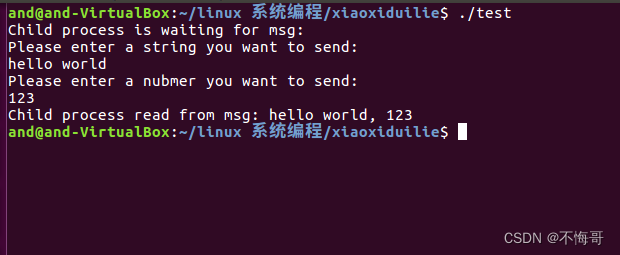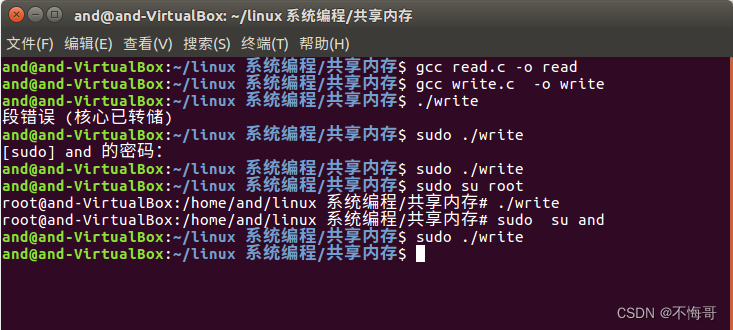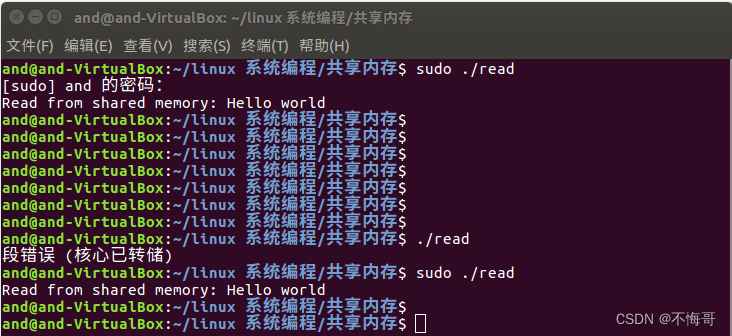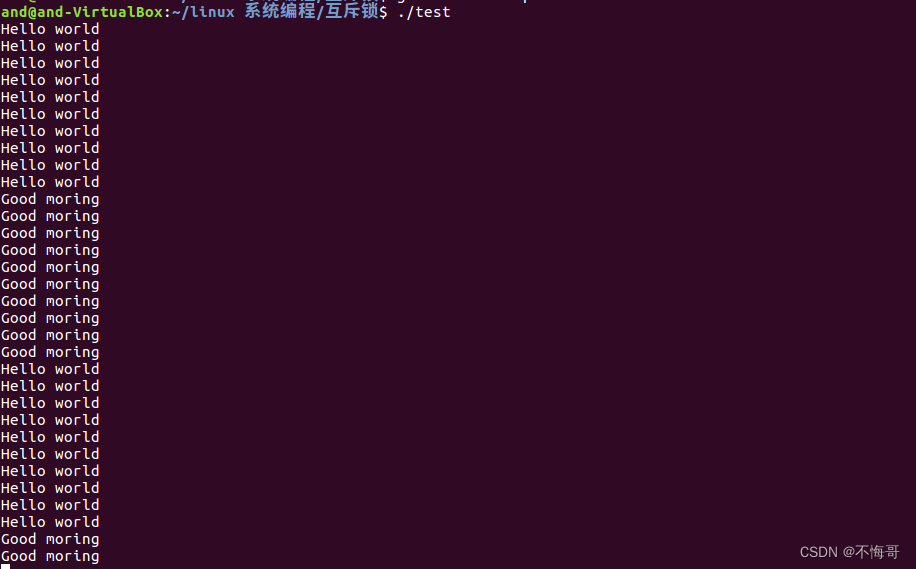一.程序进程线程概念_进程ID号
程序:源代码,指令
进程:运行着的程序
线程:线程从属于进程,一个进程可以有多个线程,线程直接共享进程的资源
任务:具体要做的事情
#include <sys/types.h>
#include <unistd.h>
#include <stdio.h>
int main(void)
{
pid_t pid;
while(1)
{
printf("pid = %d\n", getpid()); //当前进程id号
printf("ppid = %d\n", getppid());//当前进程父进程id号
printf("Hello world\n");
sleep(1);
}
return 0;
}
运行结果:

pstree -p
可以查看我们的进程树,就是进程关系

systemd(init): 所有进程的父进程
二.消息队列
#include <stdio.h>
#include <sys/ipc.h>
#include <sys/shm.h>
#include <sys/types.h>
#include <unistd.h>
#include <string.h>
#include <sys/wait.h>
#include <sys/msg.h>
#define MY_TYPE 9527
int main(void)
{
int msgid;
pid_t pid;
struct msgbuf
{
long mtype;
char mtext[100];
int number;
};
struct msgbuf buff;
msgid = msgget(IPC_PRIVATE, 0666 | IPC_EXCL); /* 不晓得为什么必须加上0666才可以*/
if (msgid == -1) {
perror("msgget");
return -1;
}
pid = fork();
if(pid > 0)
{
sleep(1);
buff.mtype = MY_TYPE;
printf("Please enter a string you want to send:\n");
gets(buff.mtext);
printf("Please enter a nubmer you want to send:\n");
scanf("%d", &buff.number);
msgsnd(msgid, &buff, sizeof(buff) - sizeof(buff.mtype), 0);
waitpid(pid, NULL, 0);
}
else if(pid == 0)
{
printf("Child process is waiting for msg:\n");
msgrcv(msgid, &buff, sizeof(buff) - sizeof(buff.mtype), MY_TYPE, 0);
printf("Child process read from msg: %s, %d\n", buff.mtext, buff.number);
}
else
perror("fork");
return 0;
}
运行效果:

用消息队队列让不同进程之间通信
接收部分代码
#include <stdio.h>
#include <sys/ipc.h>
#include <sys/shm.h>
#include <sys/types.h>
#include <unistd.h>
#include <string.h>
#include <sys/wait.h>
#include <sys/msg.h>
#define MY_TYPE 9527
#define MY_KEY 1314
int main(void)
{
int msgid;
struct msgbuf
{
long mtype;
char mtext[100];
int number;
};
struct msgbuf buff;
msgid = msgget(MY_KEY, IPC_CREAT|0644);
while(1)
{
printf("Process is waiting for msg:\n");
msgrcv(msgid, &buff, sizeof(buff) - sizeof(buff.mtype), MY_TYPE, 0);
printf("Process read from msg: %s, %d\n", buff.mtext, buff.number);
}
msgctl(msgid, IPC_RMID, NULL);
return 0;
}
发送部分代码
#include <stdio.h>
#include <sys/ipc.h>
#include <sys/shm.h>
#include <sys/types.h>
#include <unistd.h>
#include <string.h>
#include <sys/wait.h>
#include <sys/msg.h>
#define MY_TYPE 9527
#define MY_KEY 1314
int main(void)
{
int msgid;
struct msgbuf
{
long mtype;
char mtext[100];
int number;
};
struct msgbuf buff;
msgid = msgget(MY_KEY, IPC_CREAT); //ftok
buff.mtype = MY_TYPE;
printf("Please enter a string you want to send:\n");
gets(buff.mtext);
printf("Please enter a nubmer you want to send:\n");
scanf("%d", &buff.number);
msgsnd(msgid, &buff, sizeof(buff) - sizeof(buff.mtype), 0);
return 0;
}
运行效果


遇到的问题,一开始是没有用root 权限运行,导致接收消息的时候出现了死循环,但是后面发现用root权限运行之后,可以正常接收消息,但是后面再运行,发现我要发三次后,才能收到第四次的消息,试了几次都是这样,不清楚为什么。
用命令ipcs看了一下
--------- 消息队列 -----------
键 msqid 拥有者 权限 已用字节数 消息
0x00000522 0 root 0 0 0是这样的,怎么重新编译程序都不行,后面重新启动了虚拟机,发现程序是root权限的。我重新编译了一下,就可以了。

用命令ipcs重新看了一下,发现拥有者和权限那里已经变了。

三.共享内存
#include <stdio.h>
#include <sys/ipc.h>
#include <sys/shm.h>
#include <sys/types.h>
#include <unistd.h>
#include <string.h>
#include <sys/wait.h>
char msg[] = "Hello world";
int main(void)
{
int shmid;
pid_t pid;
shmid = shmget(IPC_PRIVATE, 1024, IPC_CREAT);
pid = fork();
if(pid > 0)
{
char *p_addr;
p_addr = shmat(shmid, NULL, 0);
memset(p_addr, '\0', sizeof(msg));
memcpy(p_addr, msg, sizeof(msg));
shmdt(p_addr);
waitpid(pid, NULL, 0);
}
else if(pid == 0)
{
char *c_addr;
c_addr = shmat(shmid, NULL, 0);
printf("Child process waits a short time: \n");
sleep(3);
printf("Child Process reads from shared memory: %s\n", c_addr);
shmdt(c_addr);
}
else
perror("fork");
return 0;
}
运行效果:

一个进程写共享内存,另外一个进程读共享内存
write
#include <stdio.h>
#include <sys/ipc.h>
#include <sys/shm.h>
#include <sys/types.h>
#include <unistd.h>
#include <string.h>
#include <sys/wait.h>
char msg[] = "Hello world";
#define MY_KEY 9527
int main(void)
{
int shmid;
shmid = shmget(MY_KEY, 1024, IPC_CREAT);
char *p_addr;
p_addr = shmat(shmid, NULL, 0);
memset(p_addr, '\0', sizeof(msg));
memcpy(p_addr, msg, sizeof(msg));
shmdt(p_addr);
// shmctl(shmid, IPC_RMID, NULL);
return 0;
}
read
#include <stdio.h>
#include <sys/ipc.h>
#include <sys/shm.h>
#include <sys/types.h>
#include <unistd.h>
#include <string.h>
#include <sys/wait.h>
#define MY_KEY 9527
int main(void)
{
int shmid;
shmid = shmget(MY_KEY, 1024, IPC_CREAT);
char *c_addr;
c_addr = shmat(shmid, NULL, 0);
printf("Read from shared memory: %s\n", c_addr);
shmdt(c_addr);
return 0;
}
运行效果:
先write

再read

四.互斥锁
用在线程中
pthread_mutex_init 初始化互斥锁
pthread_mutex_lock(&mutex) 上锁
要做的事情
pthread_mutex_unlock(&mutex) 解锁
#include <pthread.h>
#include <stdio.h>
#include <unistd.h>
#include <stdlib.h>
#include <semaphore.h>
void *thread1_function(void *arg);
void *thread2_function(void *arg);
pthread_mutex_t mutex;
int main(void)
{
pthread_t pthread1, pthread2;
int ret;
pthread_mutex_init(&mutex, NULL);
ret = pthread_create(&pthread1, NULL, thread1_function, NULL);
if(ret != 0)
{
perror("pthread_create");
exit(1);
}
ret = pthread_create(&pthread2, NULL, thread2_function, NULL);
if(ret != 0)
{
perror("pthread_create");
exit(1);
}
pthread_join(pthread1, NULL);
pthread_join(pthread2, NULL);
printf("The thread is over, process is over too.\n");
return 0;
}
void *thread1_function(void *arg)
{
int i;
while(1)
{
pthread_mutex_lock(&mutex);
for(i = 0; i < 10; i++)
{
printf("Hello world\n");
sleep(1);
}
pthread_mutex_unlock(&mutex);
sleep(1);
}
return NULL;
}
void *thread2_function(void *arg)
{
int i;
sleep(1);
while(1)
{
pthread_mutex_lock(&mutex);
for(i = 0; i < 10; i++)
{
printf("Good moring\n");
sleep(1);
}
pthread_mutex_unlock(&mutex);
sleep(1);
}
return NULL;
}
运行效果:先上锁,线程先打印10次,再解锁





















 5554
5554











 被折叠的 条评论
为什么被折叠?
被折叠的 条评论
为什么被折叠?








